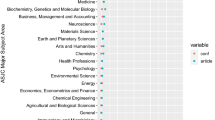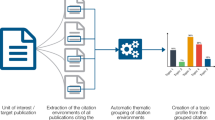Abstract
The techniques of co-citation clustering and citation context analysis are combined to concretely define the shared knowledge within a research specialty. The cluster for a large and fast moving biomedical specialty, recombinant-DNA, is presented in terms of the highly cited documents comprising it and their co-citation links. By examining citation contexts in the papers citing the highly cited documents, it is possible to label each of the documents in the cluster with its specific cognitive meaning for the citing authors. Co-citation contexts are used to reveal the relationships among the concepts symbolized by the highly cited documents, providing a cognitive equivalent of the co-citation links. This may open a new way to the investigation of the logic of conceptual change at the specialty level.
Similar content being viewed by others
References
M. MULKAY,Science and The Sociology of Knowledge, (London; Allen and Unwin, 1979).
H. G. SMALL, B. C. GRIFFITH, The Structure of Scientific Literatures I: Identifying and Graphing Specialties,Science Studies, 4 (October 1974) 17–40.
D. SULLIVAN, D. H. WHITE, E. J. BARBONI, State of a Science-Indicators in Speciality of Weak Interaction,Social Studies of Science 7 (May 1977) 167–200.
S. COLE, J. R. COLE, L. DIETRICH, Measuring the Cognitive State of Scientific Disciplines, in:Toward a Metric of Science, New York; Wiley and Sons, 1978, p. 209–251.
N. C. MULLINS, L. L. HARGENS, P. K. HECHT, E. L. KICK, Group Structure of Co-citation Clusters-Comparative Study,American Sociological Review, 42 (1977) 552–562.
M. J. MORAVCSIK, P. MURUGESAN, Some Results on the Function and Quality of Citations,Social Studies of Science, 5 (1975) 86–92.
D. E. CHUBIN, S. D. MOITRA, Content Analysis of References: Adjunct or Alternative to Citation Counting?, 423–41.
I. SPIEGEL-RÖSING, Science Studies: Bibliometric and Content Analysis,Social Studies of Science, 7 (1977) 97–113.
S. COLE, The Growth of Scientific Knowledge: Theories of Deviance as a Case Study, in:The Idea of Social Structure, L. A. COSER (Ed.), New York; Harcourt, Brace, Jovanovich, 1975, p. 175–220.
H. G. SMALL, Cited Documents as Concept Symbols,Social Studies of Science, 8 (1978) 327–340.
H. G. SMALL, A Co-citation Model of a Scientific Speciality: A Longitudinal Study of Collagen Research,Social Studies of Science, 7 (1977) 139–166.
P. H. A. SNEATH, R. R. SOKAL,Numerical Taxonomy, San Francisco; W. H. Freeman and Co., 1973, p. 131.
B. C. GRIFFITH, H. G. SMALL, The Structure of Scientific Literature II: The Macro- and Micro-Structure of Science,Science Studies, 4 (October 1974) 339–365.
J. A. HARITGAN,Clustering Algorithms, New York; Wiley and Sons, 1975, p. 199.
H. G. SMALL, Structural Dynamics of Scientific Literature,International Classification, 3 (1976) 67–74.
J. B. KRUSKAL, Multidimensional Scaling by Optimizing Goodness-of-Fit to a Non-metric Hypothesis,Psychometrika, 29 (1964) 1–37.
T. S. KUHN,The Structure of Scientific Revolutions, 2nd ed., Chicago; University of Chicago Press, 1970, p. 174.
S. N. COHEN, The Manipulation of Genes,Scientific American, 233 (1975) 25–33.
V. SGARAMELLA, Enzymatic Oligomerization of Bacteriophage P22 DNA and of Linear Simian Virus 40 DNA,Proc. Nat. Acad. Sci. U. S., 69 (1972) 3389–3393.
M. MANDEL, A. HIGA, Calcium-Dependent Bacteriophage DNA Infection,J. Mol. Biol., 53 (1970) 159–162.
See S. N. COHEN, Gene Manipulation,New England Journal of Medicine, 294 (1976) 883–889, for an explicit reference to HERSHFIELD 74 in a very similar context.
See S. N. COHEN,, for an explicit reference to KEDES 75 in a very similar context.
Author information
Authors and Affiliations
Rights and permissions
About this article
Cite this article
Small, H., Greenlee, E. Citation context analysis of a co-citation cluster: Recombinant-DNA. Scientometrics 2, 277–301 (1980). https://doi.org/10.1007/BF02016349
Received:
Issue Date:
DOI: https://doi.org/10.1007/BF02016349




